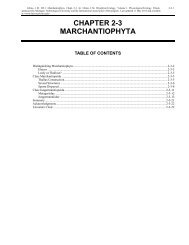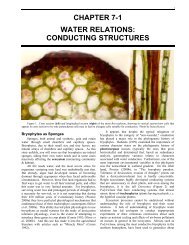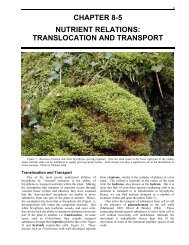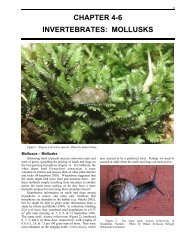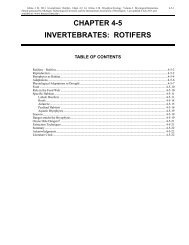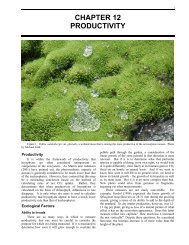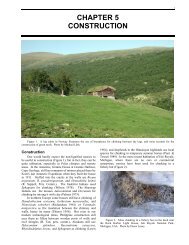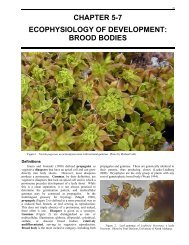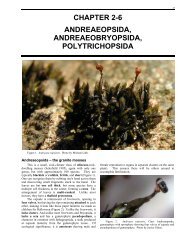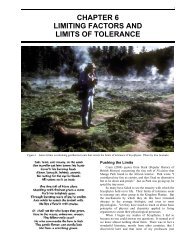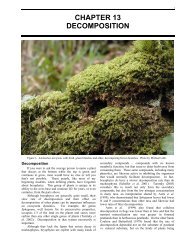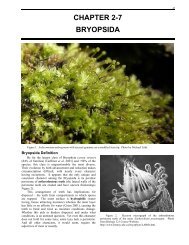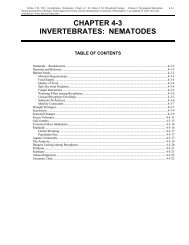Chapter 2-1: Protozoa Diversity - Bryophyte Ecology - Michigan ...
Chapter 2-1: Protozoa Diversity - Bryophyte Ecology - Michigan ...
Chapter 2-1: Protozoa Diversity - Bryophyte Ecology - Michigan ...
Create successful ePaper yourself
Turn your PDF publications into a flip-book with our unique Google optimized e-Paper software.
Glime, J. M. 2012. <strong>Protozoa</strong> <strong>Diversity</strong>. Chapt. 2-1. In: Glime, J. M. <strong>Bryophyte</strong> <strong>Ecology</strong>. Volume 2. Bryological Interaction. Ebook 2-1-1<br />
sponsored by <strong>Michigan</strong> Technological University and the International Association of Bryologists. Last updated 25 April 2012 and available<br />
at .<br />
CHAPTER 2-1<br />
PROTOZOA DIVERSITY<br />
TABLE OF CONTENTS<br />
Moss-Dwelling Micro-organisms ....................................................................................................................... 2-1-2<br />
Terminology........................................................................................................................................................ 2-1-2<br />
Abundance .......................................................................................................................................................... 2-1-3<br />
Peatlands ............................................................................................................................................................. 2-1-4<br />
<strong>Protozoa</strong> .............................................................................................................................................................. 2-1-5<br />
Zoomastigophora and flagellated Chlorophyta ................................................................................................... 2-1-6<br />
Euglenophyta ...................................................................................................................................................... 2-1-7<br />
Pyrrophyta (=Dinophyta) .................................................................................................................................... 2-1-8<br />
Ciliophora (Ciliates)............................................................................................................................................ 2-1-8<br />
Symbionts .................................................................................................................................................. 2-1-10<br />
Summary ........................................................................................................................................................... 2-1-14<br />
Acknowledgments............................................................................................................................................. 2-1-15<br />
Literature Cited ................................................................................................................................................. 2-1-15
2-1-2 <strong>Chapter</strong> 2-1: <strong>Protozoa</strong> <strong>Diversity</strong><br />
CHAPTER 2-1<br />
PROTOZOA DIVERSITY<br />
Figure 1. Actinophrys sol, a heliozoan that can sometimes be found among mosses in quiet water, with a diatom. Photo by Yuuji<br />
Tsukii.<br />
Moss-Dwelling Micro-organisms<br />
<strong>Bryophyte</strong>s are truly an elfin world, supporting diverse<br />
communities of organisms that we often can't see without a<br />
microscope. As one might expect, micro-organisms<br />
abound (Figure 1) (e.g. Leidy 1880; Maggi 1888; Penard<br />
1908; Heinis 1910; Sandon 1924; Bartos 1946, 1949a, b;<br />
Ramazotti 1958; Torumi & Kato 1961; Matsuda 1968;<br />
Smith 1974a, b; Schönborn 1977; Sudzuki 1978; Bovee<br />
1979), traversing the crevices like fleas among a dog's<br />
hairs. Bovee (1979) reported 145 taxa of protozoa from<br />
bogs in the Lake Itasca region, Minnesota, USA. In fact,<br />
there are sufficient of these organisms associated with<br />
Sphagnum that there have been books published on their<br />
identification (e.g. Hingley 1993). From forest bryophytes,<br />
Bovee found only 68 taxa. Ciliates and testate amoebae<br />
dominate the protozoa in both habitats. Even floating<br />
liverworts like Ricciocarpos natans have their associated<br />
microfauna (Scotland 1934).<br />
Gerson (1982) suggests that protozoa have evolved<br />
into the bryophyte habitat. Water that wets the mosses<br />
permits the protozoa to complete their life cycles. Moist<br />
bryophytes easily accumulate windborne dust, providing<br />
even epiphytic species with a source of nutrient matter to<br />
serve as food for bacteria and ultimately protozoa.<br />
Colonization of aerial bryophytes by micro-organisms<br />
could likewise be accomplished by wind. Dispersal of<br />
these small organisms may be similar to dispersal of spores<br />
of mosses, and the implications of their small size will be<br />
discussed later in this chapter.<br />
Terminology<br />
It has been a while since I examined the classification<br />
of the micro-organisms, so organizing this chapter turned<br />
out to be a bigger mire than I had bargained for. I am sure<br />
some of my classification is old-fashioned, but practicality<br />
has won out if I am ever to approach completion of this<br />
volume. I have tried to update where possible, but some<br />
things just don't fit there in my mind, or seem more<br />
appropriate to write about in a different place. I have<br />
decided to avoid kingdom arrangements completely, so you<br />
may find some traditional algae here and others in a chapter<br />
labelled algae.
Organisms living "firmly attached to a substratum,"<br />
but not penetrating it, are known by the German term<br />
Aufwuchs (Ruttner 1953), introduced in 1905 by Seligo<br />
(Cooke 1956). Later the term periphyton (literally<br />
meaning "around plants") was introduced for organisms<br />
growing on artificial objects in water. This term was later<br />
expanded to refer to all aquatic organisms growing on<br />
submerged surfaces. Young (1945) restricted the definition<br />
to "that assemblage of organisms growing upon free<br />
surfaces of submerged objects in water and covering them<br />
with a slimy coat" (in Cooke 1956). The use of the term<br />
has varied, including not only epiphytes (those living on<br />
plants and algae), but also organisms on non-plant<br />
substrata. Although the term Aufwuchs has enjoyed a less<br />
confusing history of meanings, Americans tend to use<br />
periphyton more frequently to refer to those microorganisms<br />
living upon a substrate. By whatever term, this<br />
group of micro-organisms often creates a rich community<br />
in association with bryophytes. This chapter will<br />
concentrate on the protozoa.<br />
Abundance<br />
One difficulty in describing the micro-organisms of<br />
bryophytes is the tedious task of sorting through and<br />
finding the organisms. Methods for finding and<br />
enumerating protozoa are discussed later in this chapter.<br />
Often identification and quantification requires culturing<br />
the organisms, which will bias the counts to those most<br />
easily cultured. Testate rhizopods are most easily located<br />
because the presence of the test permits recognition even<br />
after death. These limitations must be remembered in any<br />
discussion of abundance.<br />
Tolonen and coworkers (1992) found up to 2300<br />
individuals per cm 3 among the bryophytes in Finnish mires.<br />
These include rhizopods – those with movement by<br />
protoplasmic flow, ciliates, and flagellates (Gerson 1982).<br />
The most abundant seem to be the rhizopods (Beyens et al.<br />
1986b; Chardez 1990; Balik 1994, 2001), especially those<br />
with shells (testate) (Beyens et al. 1986a, b; Chardez &<br />
Beyens 1987; Beyens & Chardez 1994). Among these,<br />
Difflugia pyriformis (Figure 2), D. globularis,<br />
Hyalosphenia (Figure 3), and Nebela (Figure 4) are the<br />
most common among Sphagnum at Itasca, Minnesota,<br />
USA (Bovee 1979). In Pradeaux peatland in France,<br />
Nebela tincta (Figure 4) numbered an average of 29,582 L -<br />
1 active individuals, with another 2263 in encysted form<br />
(Gilbert et al. 2003).<br />
Figure 2. Difflugia pyriformis test. Photo by Yuuji Tsukii.<br />
<strong>Chapter</strong> 2-1: <strong>Protozoa</strong> <strong>Diversity</strong> 2-1-3<br />
Schönborn (1977) actually estimated the production of<br />
protozoa on the terrestrial moss Plagiomnium cuspidatum<br />
(Figure 5) and found a yearly mean of 145 x 10 6<br />
individuals per m 2 (0.11 g m -2 d -1 ). Rainfall played an<br />
important role in the dynamics of protozoa among the<br />
mosses, contributing to dislocation and modifying<br />
production. Many of the protozoa were testate amoebae<br />
that carry sand houses around with them. Heavy rains<br />
easily knock these loose and carry them to deeper layers in<br />
the soil. On the other hand, the daily death rate of these<br />
testate amoebae is lower (only 3.0% per day) than in the<br />
river itself. Furthermore, the turnover rate in mosses is<br />
much lower than in the river. The higher drying rate<br />
(higher than in soil) decreases the number of generations to<br />
about half that in soil in the same time period.<br />
Figure 3. Hyalosphenia papilio showing test and ingested<br />
algae. Photo by Ralf Meisterfeld.<br />
Figure 4. Nebela tincta test. Photo by Yuuji Tsukii.<br />
In temperate forests of northeastern USA, Anderson<br />
(2008) identified 50 morphospecies of non-testate<br />
amoebae, averaging 17 per sample, based on lab cultures.<br />
Densities ranged 3.5 x 10 3 to 4.3 x 10 4 gdm -1 of moss. As<br />
in other studies, numbers were highly correlated with<br />
moisture content of the mosses (p < 0.001). These numbers
2-1-4 <strong>Chapter</strong> 2-1: <strong>Protozoa</strong> <strong>Diversity</strong><br />
exceeded those of soil, perhaps due to the heavier weight of<br />
soil per unit volume. As expected, number of encysted<br />
forms was inversely related to moisture content.<br />
Figure 5. Plagiomnium cuspidatum, a terrestrial moss<br />
habitat. Photo by Michael Lüth.<br />
Peatlands<br />
Peatlands are unique habitats dominated by mosses.<br />
Because of their moist nature, they are home to numerous<br />
micro-organisms (Warner 1987; Kreutz & Foissner 2006)<br />
and will warrant their own sections as we talk about many<br />
of the groups of organisms that inhabit mosses.<br />
In addition to the moist habitat of the peatland mosses,<br />
peatlands provide numerous small pools, hollows,<br />
channels, and small lakes that are ideal habitats for some<br />
micro-organisms. Using glass slides, Strüder-Kypke<br />
(1999) examined the seasonal changes in these microorganisms<br />
in dystrophic bog lakes at Brandenburg,<br />
Germany. May brought ciliates and choanoflagellates and<br />
the highest degree of species diversity for the year. This<br />
community was replaced by one dominated by peritrich<br />
ciliates from August to October. Their decline coincided<br />
with early frost, yielding to a winter periphyton of small<br />
heterotrophic flagellates. The pioneers on the slides were<br />
bacterivorous ciliates.<br />
Peatlands typically have vertical community<br />
differences, as will be seen as we discuss the various<br />
groups. Diminishing light restricts the photosynthetic<br />
organisms and those protozoa with zoochlorellae (algal<br />
symbionts) to the upper portion of the Sphagnum. In the<br />
German bog lakes, Strüder-Kypke (1999) found that this<br />
zone was characterized by autotrophic cryptomonads and<br />
mobile ciliates. Deeper portions were colonized by<br />
heterotrophic flagellates and sessile peritrich ciliates.<br />
Cyclidium sphagnetorum (Figure 6) is known only<br />
from Sphagnum and is thus a bryobiont (Grolière 1978 in<br />
Gerson 1982). In fact, Sphagnum usually has the richest<br />
bryofauna of any moss, as shown by Bovee (1979) in<br />
Minnesota. In Canada, a single gram of Sphagnum<br />
girgensohnii (Figure 7) housed up to 220,000 individuals<br />
of protozoa, mostly flagellates, while Campylium<br />
chrysophyllum (Figure 8) had a maximum of only 150,000<br />
in the same habitat (Table 1; Fantham & Porter 1945),<br />
suggesting there might be important microhabitat<br />
differences among bryophyte species. In Westmorland, the<br />
numbers translate to a mere 16 million of these animals in a<br />
single<br />
square meter of Sphagnum (Heal 1962).<br />
Figure 6. Cyclidium sp. (Ciliophora). Photo by Yuuji<br />
Tsukii.<br />
Sphagnum is a particularly common habitat for microorganisms<br />
(Chacharonis 1956; deGraaf 1957). It appears<br />
that even the surface of Sphagnum may offer a unique<br />
community. Gilbert et al. (1998, 1999) considered that<br />
these surface organisms might play an important role in<br />
recycling nutrients using the microbial loop, an<br />
energy/carbon pathway wherein dissolved organic carbon<br />
re-enters the food web through its incorporation into<br />
bacteria. Changes in these bryophyte protozoan<br />
communities could alter the return of nutrients through the<br />
microbial loop and indicate the degree of human<br />
disturbance.<br />
Figure 7. Sphagnum girgensohnii, a peatmoss that can<br />
house up to 220,000 individuals in 1 gram of protozoa. Photo by<br />
Michael Lüth.<br />
Figure 8. Campylium chrysophyllum, a peatland species<br />
that may be less hospitable to protozoa than Sphagnum, but still<br />
can house 150,000 in just 1 gram. Photo by Michael Lüth.
<strong>Chapter</strong> 2-1: <strong>Protozoa</strong> <strong>Diversity</strong> 2-1-5<br />
Table 1. Number of individuals occupying Sphagnum per gram dry moss. From Fantham & Porter 1945 in Hingley 1993.<br />
naked testate<br />
amoebae rhizopods flagellates ciliates rotifers nematodes<br />
S. papillosum 440 3640 9920 1000 160 120<br />
S. subsecundum 1344 1712 26672 2224 176 64<br />
S. palustre 240 3360 5880 2080 120 360<br />
S. girgensohnii ————————over 220000———————— 1160 4680<br />
In their comparison of the protozoan groups and other<br />
small invertebrates on four Sphagnum species, Fantham<br />
and Porter (1945) found that Sphagnum girgensohnii<br />
supported the most protozoa, rotifers, and nematodes, and<br />
that flagellates were the most common on all four<br />
Sphagnum species (Table 1). Unfortunately, most<br />
extraction techniques do not work well for examining the<br />
flagellates, so it is likely that they are more common than<br />
most studies indicate.<br />
We might well ask why Sphagnum girgensohnii was<br />
the preferred moss. This species tends to occur on higher<br />
ground and in forests where it is not submersed for<br />
significant periods of time and it is usually possible for<br />
protozoa and other small invertebrates to seek out higher<br />
parts of the plants to escape drowning. Water is not always<br />
a good thing.<br />
The richness of the invertebrate fauna in peatlands is<br />
rather astounding in view of the antibiotic properties of<br />
Sphagnum. Its polyphenolic compounds could not only<br />
discourage herbivory on the moss, but reduce the<br />
availability of micro-organisms, especially bacteria, that<br />
might otherwise live there and serve as food for<br />
invertebrate inhabitants (Verhoeven & Liefveld 1997).<br />
Smirnov (1961) could find only one invertebrate species<br />
that ate the Sphagnum – Psectocladium psilopterus – a<br />
chironomid (midge) larva. Other fauna ate mostly algae<br />
from the surface. Nevertheless, microfauna seem to<br />
abound in a wide diversity of species and numbers among<br />
the Sphagnum (Smirnov 1961; Tolonen et al 1992; Gilbert<br />
et al. 1999), despite the fact they are on the menu at this<br />
mossy restaurant.<br />
<strong>Protozoa</strong><br />
Although <strong>Protozoa</strong> was once a recognized taxonomic<br />
unit, it is now only a convenient name used to describe the<br />
heterotrophic flagellates, ciliates, and amoebae. Of the<br />
now-recognized four major groups of protozoa, three can<br />
be found in association with bryophytes. These are<br />
Sarcodina – rhizopods (amoebae), Ciliophora – ciliates,<br />
and Mastigophora – flagellates (Chiba & Kato 1969;<br />
Gerson 1982). Bamforth (1973) described two nutritional<br />
protozoan groups associated with plant communities. The<br />
naked taxa are primarily bacterivores (consume bacteria)<br />
and depend on the decomposability of the litter (including<br />
bryophytes) where they live. The Testacea (those<br />
rhizopods living in a shell of their own making) are more<br />
slow growing, associate with humus and mosses, and live<br />
where the humus is of slow decomposability. These<br />
characteristics make bryophytes suitable substrates.<br />
The most important factor in determining the<br />
habitation by the protozoa is moisture. This determines<br />
which species can occur there, what food is available, and<br />
whether the protozoan is active or dormant. Mosses act<br />
much like a sponge, absorbing water that is available from<br />
the soil, rain, and atmosphere, and retaining it. As such,<br />
they provide a moist safe haven for protozoans to continue<br />
an active life long after other surfaces are dry. But they<br />
also help to slow the drying of their underlying substrate<br />
and provide insulation against heat, cold, and wind,<br />
increasing the utility of the substrate, especially soil, as<br />
well (Das 2003).<br />
Gerson (1982) has described four categories of<br />
bryophyte fauna, based on their occurrence among<br />
bryophytes: bryobionts – animals that occur exclusively<br />
in association with bryophytes; bryophiles – animals that<br />
are usually found among bryophytes but may survive<br />
elsewhere; bryoxenes – animals that regularly spend part<br />
of their life cycle on bryophytes; occasionals – animals that<br />
may at times be found among bryophytes but do not<br />
depend on them for survival.<br />
In a study of Polish peatlands, Mieczan (2006) named<br />
four categories of protozoa that inhabited the peatlands,<br />
based on percent presence: very constant species (in 61-<br />
100 percent of the samples), constant species (in 41-60<br />
percent), accidental species (in 21-40 per cent), accessory<br />
species (in less than 20 per cent). Although this system<br />
aligns closely with that of Gerson (1982), it has the<br />
advantage that one does not need to know the occurrence of<br />
the species elsewhere and it is more quantitative. On the<br />
other hand, that quantification requires considerable time to<br />
determine.<br />
As already noted, the richest protozoan habitat among<br />
the mosses is considered to be Sphagnum, with up to 16<br />
million individuals m -2 (Richardson 1981). Whereas<br />
Sphagnum provides a moist habitat, Drepanocladus (sensu<br />
lato; Figure 9), a rich fen species, may be a better habitat<br />
by trapping more nutrients (Gerson 1982). In that habitat,<br />
the amount of available nutrients determined the numbers<br />
of protozoa, due to the greater availability of microbes and<br />
organic matter that served as food sources.<br />
Figure 9. Drepanocladus (=Limprichtia) revolvens, a<br />
species among the brown mosses that live in rich fens. Photo by<br />
Michael Lüth.
2-1-6 <strong>Chapter</strong> 2-1: <strong>Protozoa</strong> <strong>Diversity</strong><br />
In his study of Polish peatlands, Mieczan (2006) found<br />
24 taxa of ciliates and 6 of testate amoebae among mosses.<br />
But he considered the majority of these to be accidental or<br />
accessory species.<br />
Even dry cryptogamic crusts of prairies and deserts<br />
sport a diverse fauna of protozoa. In the Grand Canyon,<br />
Arizona, USA, 51 species of ciliates, 28 of amoebae, 17 of<br />
Testacea, 4 metazoan taxa, and a number of flagellate<br />
morphotypes were present in the water film among just 28<br />
microbiotic crust samples (Bamforth 2003). These crusts<br />
were composed of Cyanobacteria, lichens, and bryophytes.<br />
In the predominating non-flagellated protozoan groups, rselected<br />
(high level of reproduction, small body size, short<br />
generation time) bacterivores respond rapidly to wetting,<br />
quickly exploit resources, then encyst when unfavorable<br />
conditions return. It seems that these protozoan groups and<br />
bryophytes were made for each other (Kunz 1968).<br />
Zoomastigophora (Flagellates) and<br />
flagellated Chlorophyta<br />
Like Euglenophyta, flagellated green algae (flagellated<br />
Chlorophyta) are placed in this sub-chapter because of<br />
their movement capability and ecological relationships,<br />
especially with peat.<br />
The flagellates, known as Zoomastigophora, swim by<br />
means of 1-4 long flagella and thus require at least a film of<br />
water. Fortunately, some are able to encyst, enabling them<br />
to become dormant when that film of water is absent.<br />
As one might suspect, Sphagnum can provide long<br />
periods when leaves have a thin film of water. Numbers<br />
of flagellates can reach 10 7 cells L -1 (Gilbert & Mitchell<br />
2006). For the green alga Carteria sphagnicola (Figure<br />
10) Sphagnum provides an unique habitat, with its cation<br />
exchange making its surrounding water acid. This would<br />
be particularly true of a thin film of water that is not diluted<br />
by lake or fen water.<br />
Figure 10. Carteria sphagnicola, a peatland inhabitant.<br />
Photo by Yuuji Tsukii.<br />
Chlamydomonas (Figure 11), a green alga, is a<br />
relatively common genus in peatlands. Chlamydomonas<br />
acidophila, as its name implies, lives at low pH and is<br />
common among Sphagnum plants with a pH of 2-6, where<br />
as many as 50,000 individuals may exist per cm 2 (Hingley<br />
1993). Another Chlamydomonas species, known first from<br />
Sphagnum, has been named C. sphagnicola.<br />
Figure 11. Chlamydomonas moewusii. Photo by Yuuji<br />
Tsukii.<br />
One advantage that the widely known genus<br />
Chlamydomonas shares with many of the bryophyteinhabiting<br />
protozoa is the ability to form a palmelloid stage<br />
(Figure 12) – a stage that can remain dormant during dry<br />
spells (Rajan 202). This stage is named because of its<br />
resemblance to the green algal genus Palmella. In<br />
Chlamydomonas, to form the palmella stage, the cells lose<br />
their flagella, divide, and form a gelatinous ball in which<br />
the cells are embedded. Each cell is still capable of<br />
individual function. When favorable conditions return,<br />
individual cells are freed and continue an active life.<br />
Figure 12. Chlamydomonas, a genus that can inhabit the<br />
hyaline cell of Sphagnum. Upper: vegetative cell. Lower:<br />
palmelloid stage. Photos by Jason Oyadomari.<br />
Chlamydomonas reinhardtii is known to form<br />
gelatinous masses or a palmelloid stage (Figure 13) when<br />
confronted by the predator Brachionus calyciflorus, a<br />
rotifer (Lurling & Beekman 2006). The reaction to form a<br />
palmelloid stage can occur within 25 hours and apparently<br />
affords some protection against rotifer grazing. The low<br />
pH of the Sphagnum habitat may contribute to this ability;<br />
calcium can cause the palmelloid stage to dissociate, but<br />
phosphorus can negate the dissociation (Iwasa & Murakami
1969). Iwasa and Murakami suggest that organic acids<br />
(such as those produced by Sphagnum) chelate calcium<br />
and permit the formation of the palmelloid stage.<br />
Nakamura et al. (1976) have shown that there are other<br />
biochemical/chemical interactions that can inhibit the<br />
formation of the palmelloid stage in Chlamydomonas<br />
eugametos, suggesting that rotifers, and other organisms,<br />
could emit biochemicals that stimulate or interfere with<br />
palmelloid formation. Among bryophytes, cohabitation<br />
with rotifers is likely to occur frequently, so one should<br />
look for these special reactions.<br />
Figure 13. Chlamydomonas close view of palmelloid stage.<br />
Photo<br />
by Jason Oyadomari.<br />
Henebry and Cairns<br />
(1984) found the flagellated<br />
Chlorophyta<br />
Chilomonas, Monas, and Monasiga<br />
associated with Sphagnum in peatlands. Additional<br />
members of bryophyte associations are listed in Table 2.<br />
Euglenophyta<br />
Euglena (Figure 14)<br />
is one of those organisms that<br />
caused<br />
consternation among early classifiers because of its<br />
combination of animal and plant traits. It can engulf food,<br />
but it also has chlorophyll and a flagellum. I have<br />
stubbornly used its algal name here but am writing about it<br />
with the protozoa because of its flagella. Additional<br />
Euglenophyta are listed in Table 2.<br />
Figure 14. Euglena in a poor fen collection at Perrault Fen,<br />
Houghton County, <strong>Michigan</strong>, USA. Photo by Jason Oyadomari.<br />
<strong>Chapter</strong> 2-1: <strong>Protozoa</strong> <strong>Diversity</strong> 2-1-7<br />
Euglena mutabilis (Figure 15) can withstand pH as<br />
low as 1.8, numbering 50,000-70,000 per cm<br />
surf<br />
2 of ground<br />
ace (Hingley 1993). Its numbers, like those of many<br />
other Sphagnum organisms, correlate positively with<br />
moisture content of the peat. Euglena mutabilis, common<br />
in the upper 2 cm of peat, lacks the flagellum that is typical<br />
of euglenoids and has only two chloroplasts. Of special<br />
interest is its ability to live inside hyaline cells of the<br />
Sphagnum leaves (Figure 16, Figure 17). Sphagnum<br />
species with hooded leaves seem to house more euglenoids<br />
than do other kinds of Sphagnum. The "hood" most likely<br />
helps to create a micro-basin for trapping water. Some of<br />
these tiny unicellular organisms, like Euglena mutabilis,<br />
enter through the Sphagnum leaf pores and live within the<br />
hyaline cells (these are non-living), dining on organic<br />
debris left by former residents.<br />
Figure 15. Euglena mutabilis. Photo by Yuuji Tsukii.<br />
Figure 16. Microscopic view of Sphagnum leaf showing<br />
hyaline cells and pores. Photo with permission from<br />
.<br />
Figure 17. SEM of Sphagnum hyaline cells, showing pores.<br />
Photo from .
2-1-8 <strong>Chapter</strong> 2-1: <strong>Protozoa</strong> <strong>Diversity</strong><br />
Despite their lack of a test, Euglena acus (Figure 18)<br />
and Phacus longicaudatus (Figure 19) can survive<br />
desiccation for more than seven years with no test to<br />
protect them (Hingley 1993).<br />
Figure 18. Euglena acus showing distinctive red eyespot<br />
that permits it to respond to light. Photo by Jason Oyadomari.<br />
Figure 19. Phacus longicauda, a not-so-common member<br />
of the bryophytic protozoan fauna. Photo by Yuuji Tsukii.<br />
Pyrrophyta (=Dinophyta)<br />
The name Pyrrophyta literally means fire plants, and<br />
these organisms are so-named because<br />
of the ability of<br />
some species to produce flashes of light through<br />
bioluminescence. Sadly, these spectacular show-offs are<br />
rarely known from bryophytes (Table 2). I have located<br />
only one Pyrrophyta species known commonly to inhabit<br />
bryophytes – Hemidinium ochraceum (Hingley 1993;<br />
Figure 20). But that gives me an excuse to write about<br />
these remarkable organisms, also known as<br />
dinoflagellates. Hemidinium ochraceum lives among the<br />
Sphagnum in hollows of peatlands where they give the<br />
Sphagnum a yellowish-rusty color (Hingley 1993).<br />
Figure 20. The dinoflagellate Hemidinium sp. Photo by<br />
Yuuji Tsukii.<br />
Whereas some dinoflagellates (so-named because of<br />
their twirling motion) attract attention by their brilliant<br />
displays,<br />
others attract it by their deadly toxins. They are<br />
the apparent cause of the water that "turned to blood" as<br />
reported in Exodus of the Bible – red tide organisms known<br />
today for the resulting unpleasant odors of dying fish and in<br />
some cases very strange effects on humans. Some wear<br />
plates of armor and others do not. Their two flagella lie in<br />
grooves, one around the middle of the cell like a sash and<br />
the other extending from that line down the "back" and up<br />
the "front," resulting in their characteristic twirling motion.<br />
It is not surprising that they avoid peatlands because most<br />
of them prefer alkaline conditions (Hingley 1993).<br />
Ciliophora (Ciliates)<br />
These organisms use a series of fine cilia instead<br />
of<br />
flagella to achieve movement.<br />
Some of these, despite their<br />
cilia, attach themselves to Sphagnum leaves (Hingley<br />
1993).<br />
The cilia can serve more than one function.<br />
Whereas the primary one is to direct food into the cell,<br />
many also use them for locomotion.<br />
Numbers of ciliates among Sphagnum water range 0-<br />
4.2 x 10<br />
the bryophytes as a<br />
subs<br />
sym<br />
6 cells L -1 (Gilbert & Mitchell 2006). Many of<br />
these organisms may simply use<br />
trate. Such is probably the case for the stalked<br />
Vorticella (Figure 21, Figure 22). Nevertheless, detrital<br />
matter that accumulates and algae and bacteria that take up<br />
residence among the leaves most likely provide food for<br />
ciliates, whether confined by an attachment or free-moving.<br />
Some ciliates occur only among Sphagnum (Figure<br />
23), including Bryometopus (Figure 24) and<br />
Climacostomum (Figure 25), the latter often with<br />
bionts (Figure 26) (Gilbert & Mitchell 2006). Other<br />
taxa that Mieczan (2006) found to be very constant in<br />
Polish peatlands include Askenasia sp., Chlamydonella<br />
spp., Enchelyomorpha vermicularis (70%), Gastronauta<br />
spp. (89%), Paramecium putrinum, and Trochilia minuta.<br />
Figure 21. Upper: A member of the genus Vorticella that<br />
was living on the leaves of the leafy liverwort Jungermannia<br />
cordifolia. Lower: This same Vorticella is shown here with its<br />
stalk extended. Photos by Javier Martínez Abaigar.
Figure 22. Vorticella, a stalked ciliate that inhabits<br />
bryophyte leaves and other aquatic substrates. Photo by Jason<br />
Oyadomari.<br />
Figure 23. Sphagnum obtusum showing the wet capillary<br />
spaces among the leaves that support ciliate protozoan<br />
communities on these drooping branches. Photo by Michael Lüth.<br />
The ciliates have a distinct zonation within the<br />
peatland, and different communities, fewer in number of<br />
individuals and species, occur at the depth of the non-green<br />
Sphagnum parts (Hingley 1993). Those with symbiotic<br />
algal<br />
partners require light and are thus restricted to areas<br />
near the surface where the Sphagnum likewise is green.<br />
However, some symbiotic ciliates are also able to ingest<br />
food and can thus also live farther down the stems.<br />
Figure 24. A ciliate, possibly Bryometopus, a bryobiont of<br />
Sphagnum, showing photosynthetic symbionts. Photo by Yuuji<br />
Tsukii.<br />
<strong>Chapter</strong> 2-1: <strong>Protozoa</strong> <strong>Diversity</strong> 2-1-9<br />
Figure 25. Climacostomum virens with no symbionts.<br />
Photo by Yuuji Tsukii.<br />
Figure 26. Climacostomum virens with dense symbionts.<br />
Photos by Yuuji Tsukii.<br />
Like many other protozoa, the ciliates can survive<br />
drought by encysting. Paramecium aurelia (see Figure 27-<br />
Figure<br />
28 for genus) can survive more than seven years<br />
w ith no test to protect it (Hingley 1993).
2-1-10 <strong>Chapter</strong> 2-1: <strong>Protozoa</strong> <strong>Diversity</strong><br />
Figure 27. Paramecium, the slipper animal, is a ciliate that<br />
is larger than most protozoa. Photo by Jason Oyadomari.<br />
Figure 28. Paramecium showing two of its round contractile<br />
vacuoles that permit it to regulate its water content. Photo by<br />
Jason Oyadomari.<br />
The Sphagnum-dwelling ciliate Podophyra sp. (Figure<br />
29) has tentacles that are necessary in its capture of prey.<br />
These<br />
have a knob at the end that excretes substances that<br />
narcotize the prey (Samworth). The interesting part of this<br />
trapping mechanism is that the cytoplasm is sucked down<br />
these tentacle arms to the body and the prey, such as the<br />
ciliate Colpidium (Figure 30), remains alive during the<br />
journey! The prey organism is finally absorbed into the<br />
body of the Podophyra. But stranger still it is that the prey<br />
organism may be released, still alive, after the Podophyra<br />
has finished feeding!<br />
Figure 29. Podophyra, a ciliate found in Perrault Fen,<br />
Houghton County, <strong>Michigan</strong>, USA. Photo by Jason Oyadomari.<br />
Figure 30. Colpidium campylum. Photo by Yuuji Tsukii.<br />
Symbionts<br />
Many of the ciliates have their own symbiotic<br />
residents. Those ciliates living near the surface of<br />
bryophyte communities where there is ample light often<br />
incorporate photosynthetic algae inside their cells (Figure<br />
31), benefitting from the oxygen and photosynthate, and<br />
contributing CO2 to the algae (Hingley 1993). The algae<br />
can also transfer organic nitrogen, phosphorus, and sulfur<br />
and excrete glycerol, glucose, alanine, organic acids, and<br />
carbohydrate released as maltose (Arnold 1991; Dorling et<br />
al. 1997). In return, the symbiotic algae can gain inorganic<br />
forms of nitrogen, phosphorus, and sulfur and may gain<br />
vitamins, while enjoying the safety of a moist cell. Wang<br />
(2005) reported that protozoa with<br />
algae seemed to be<br />
favored<br />
by higher oxygen concentrations with concomitant<br />
higher concentrations<br />
of CO2. This higher CO2<br />
undoubtedly aided the algae in their photosynthesis inside<br />
the diffusion barrier of the protozoan cell.<br />
Figure 31. Colpoda with Chlorophyta symbionts. Photo by<br />
Yuuji Tsukii.<br />
When the alga is to be used as a symbiont, it is<br />
protected within a vacuole by a double membrane.<br />
Somehow the host cell knows not to digest these, whereas<br />
those doomed as food are located in vacuoles that merge<br />
with lysosomes and are digested (Karakashian &<br />
Rudzinska 1981). In Hydra, it is the maltose that<br />
apparently signals the host not to digest its symbiont<br />
(McAulay & Smith 1982 in Arnold 1991), and this may<br />
also be the means of recognition in the protozoa. Anderson<br />
(1983) suggests that the protozoan may still later digest<br />
some of the symbionts, making these photosynthetic
organisms into an internal garden to be harvested as<br />
needed.<br />
As in Frontalis, the alga may survive with or without<br />
symbionts (Figure 32). The common Paramecium<br />
bursaria is likely to be home for numerous cells of<br />
Chlorella (Figure 33), but it can also have the alga<br />
Scenedesmus as a partner (Arnold 1991). Among the<br />
ciliate symbiotic hosts, Cyclidium sphagnetorum (see<br />
Figure 34) is one of the common ciliate species among<br />
peatland bryophytes (Groliére 1977). Others include<br />
Frontonia vernalis (Figure 35), Platyphora similis (Figure<br />
36), and Prorodon viridis (Figure 37). Additional species<br />
are listed in Table 2.<br />
Figure 32. Frontonia, a peatland-dwelling ciliate. Upper:<br />
Cell shape and nucleus. Lower: Frontonia vernalis cell with<br />
Chlorella symbionts and desmids (food items?) in the cell.<br />
Photos<br />
by Yuuji Tsukii.<br />
Figure 33. Paramecium bursaria (left), a common ciliate<br />
that can inhabit bryophytes, showing its Chlorella symbionts.<br />
Photo by Yuuji Tsukii.<br />
<strong>Chapter</strong> 2-1: <strong>Protozoa</strong> <strong>Diversity</strong> 2-1-11<br />
Figure 34. Cyclidium, a genus that often has algal<br />
symbionts. Photo by Yuuji Tsukii.<br />
Figure 35. Frontonia, a peatland-dwelling ciliate with<br />
Chlorella symbionts and desmids in the cell. Photo by Yuuji<br />
Tsukii.<br />
Figure 36. Platyophora similis, a ciliate known from<br />
Sphagnum<br />
in Poland (Mieczan 2006). It appears to have both<br />
small<br />
algal symbionts and larger ingested algae or Cyanobacteria.<br />
Photo by Yuuji Tsukii.<br />
One possible additional advantage to having<br />
symbionts, aside from the added energy availability, is that<br />
it permits these ciliates to live where the oxygen supply is<br />
low, deriving their oxygen from their symbionts (Lawton<br />
1998). This strategy provides them the opportunity to<br />
avoid the more oxygen-dependent larger metazoans that<br />
might otherwise have them for dinner. In the words of<br />
Lawton, it provides "enemy-free space."
2-1-12 <strong>Chapter</strong> 2-1: <strong>Protozoa</strong> <strong>Diversity</strong><br />
Figure 37. Prorodon viridis, a ciliate that inhabits<br />
Sphagnum<br />
in peatlands of Poland (Mieczan 2006). It is packed<br />
with algal symbionts with a colorless nucleus in the center. Photo<br />
by Yuuji Tsukii.<br />
Coleps hirtus (Figure 38-Figure 40) is a facultative<br />
host<br />
to the Chlorella symbiont (Auer et al. 2004), but it<br />
grows faster when it is in the light and endowed with<br />
endosymbionts (Stabell et al. 2002). Even when it has<br />
endosymbionts, it will ingest organic matter, including<br />
smaller protozoa and algae (Figure 41-Figure 42; Auer et<br />
al. 2004). The alga maintains a coordinated growth rate<br />
with the host by its rate of leakage of products to the host.<br />
Figure 38. Coleps hirtus, a peatland inhabitant found by<br />
Mieczan (2006) in Poland. Cells have internal symbiotic algae.<br />
Photo by Yuuji Tsukii.<br />
Figure 39. Coleps hirtus test, showing spines, with diatom.<br />
Photo by Yuuji Tsukii.<br />
Figure 40. Coleps hirtus with internal symbiotic algae.<br />
Photo by Yuuji Tsukii.<br />
Figure 41. Coleps ingesting the green alga Chlorogonium.<br />
Photo by Yuuji Tsukii.<br />
Figure 42. Coleps feeding on the diatom Diatoma. Photos<br />
by Yuuji<br />
Tsukii.
<strong>Chapter</strong> 2-1: <strong>Protozoa</strong> <strong>Diversity</strong> 2-1-13<br />
Table 2. Species and genera of Zoomastigophora, flagellate Chlorophyta, Euglenophyta, Pyrrophyta, armored flagellates,<br />
Ciliophora, Heliozoa, Cryptophyta, and Ochrophyta I have located in the literature and from observations of protozoologists as those<br />
known from bryophytes. Those reported by Hingley are known from peatlands. *Indicates closely associated with Sphagnum.<br />
Additional photographs are in <strong>Chapter</strong> 2-2 of this volume.<br />
Zoomastigophora<br />
Distigma proteus Hingley 1993<br />
Flagellate Chlorophyta<br />
Carteria globosa Hingley 1993<br />
Carteria sphagnicola Compére 1966<br />
Chilomonas Henebry & Cairns 1984<br />
Chlamydomonas acidophila* Hingley 1993<br />
Chlamydomonas sphagnicola* Hingley 1993<br />
Gonium pectorale<br />
Hingley 1993<br />
Gonium sociale Hingley 1993<br />
Hyalogonium klebsii<br />
Hingley 1993<br />
Monas Henebry & Cairns 1984<br />
Monasiga Henebry & Cairns 1984<br />
Platydorina Hingley 1993<br />
Polytoma uvella Hingley 1993<br />
Spermatozopsis Hingley 1993<br />
Euglenophyta<br />
Astasia Hingley 1993<br />
Distigma Hingley 1993<br />
Euglena acus Hingley 1993<br />
Euglena deses Hingley 1993<br />
Euglena mutabilis* Hingley 1993<br />
Euglena oxyuris Hingley 1993<br />
Euglena pisciformis Hingley 1993<br />
Euglena sanguinea Hingley 1993<br />
Euglena spirogyra Hingley 1993<br />
Euglena<br />
tripteris Hingley 1993<br />
Euglena viridis Hingley 1993<br />
Lepocinclis Hingley 1993<br />
Phacus longicaudatus Hingley 1993<br />
Trachelomonas aculeata Hingley 1993<br />
Trachelomonas bulla Hingley 1993<br />
Trachelomonas hispida Hingley 1993<br />
Pyrrophyta & Armored Flagellates<br />
Amphidinium Hingley 1993<br />
Ceratium hirundinella Hingley 1993<br />
Cystodinium conchaeforme* Hingley 1993<br />
Dinococcales – epiphytes Hingley 1993<br />
Glenodinium Hingley 1993<br />
Gymnodinium caudatum Hingley 1993<br />
Gyrodinium Hingley 1993<br />
Hemidinium ochraceum* Hingley 1993<br />
Katodinium stigmatica Hingley 1993<br />
Katodinium vorticella Hingley 1993<br />
Peridinium cinctum Hingley 1993<br />
Peridinium inconspicuum Hingley 1993<br />
Peridinium limbatum Hingley 1993<br />
Peridinium umbonatum Hingley 1993<br />
Peridinium volzii Hingley 1993<br />
Peridinium willei Hingley 1993<br />
Sphaerodinium Hingley 1993<br />
Woloszynskia Hingley 1993<br />
Ciliophora<br />
Amphileptus pleurosigma Bourland pers. obs.<br />
Askenasia Mieczan 2006<br />
Blepharisma lateritium Hingley 1993<br />
Blepharisma steini Hingley 1993<br />
Blepharisma musculus Hingley 1993<br />
Blepharisma sphagni* Hingley 1993<br />
Bryometopus pseudochilodon Hingley 1993<br />
Bryometopus sphagni* Hingley 1993<br />
Bryophyllum armatum Hingley 1993<br />
Bryophyllum penardi Hingley 1993<br />
Bryophyllum vorax Hingley 1993<br />
Bursaria truncatella Hingley 1993<br />
Chaenea Hingley 1993<br />
Chilodonella bavariensis Hingley 1993<br />
Chilodonella cucullus Hingley 1993<br />
Chilodonella uncinata Hingley 1993<br />
Chilodontopsis depressa Bourland pers. obs.<br />
Chlamydonella Mieczan 2006<br />
Cinetochilum<br />
margaritaceum Bourland pers. obs.<br />
Climacostomum virens Gilbert & Mitchell 2006<br />
Climacostomum – zoochlorellae<br />
Hingley 1993<br />
Coleps Hingley 1993<br />
Colpidium Hingley 1993<br />
Colpoda steinii Mieczan 2006<br />
Cyclidium glaucoma Hingley 1993<br />
Cyclidium sphagnetorum – zoochlorellae Hingley 1993<br />
Cyclogramma protectissima Hingley 1993<br />
Cyrtolophosis mucicola Hingley 1993<br />
Didinium nasutum Bourland pers. obs.<br />
Dileptus tenuis Hingley 1993<br />
Drepanomonas dentata Hingley 1993<br />
Drepanomonas exigua Hingley 1993<br />
Drepanomonas sphagni* Hingley 1993<br />
Enchelyodon ovum Hingley 1993<br />
Enchelyodon sphagni* Hingley 1993<br />
Enchelyomorpha vermicularis Mieczan 2006<br />
Euplotes patella Hingley 1993<br />
Frontonia vernalis Groliére 1977<br />
Gastronauta (Ciliophora) Mieczan 2006<br />
Gonostomum affine Hingley 1993<br />
Halteria grandinella Hingley 1993<br />
Hemicyclostyla sphagni Hingley 1993<br />
Histriculus sphagni* Hingley 1993<br />
Holophrya – zoochlorellae Hingley 1993<br />
Keronopsis monilata Hingley 1993<br />
Keronopsis muscorum Hingley 1993<br />
Keronopsis wetzeli Hingley 1993<br />
Lacrymaria olor Hingley 1993<br />
Lembadion Hingley 1993<br />
Leptopharynx costatus – zoochlorellae Hingley 1993<br />
Litonotus fasciola Hingley 1993<br />
Malacophrys sphagni* Hingley 1993<br />
Microthorax spiniger Hingley 1993<br />
Monodinium Bourland pers. obs.<br />
Ophrydium versatile – zoochlorellae Hingley 1993<br />
Opisthotricha muscorum Hingley 1993<br />
Opisthotricha parallela Hingley 1993<br />
Opisthotricha sphagni Hingley 1993<br />
Oxytricha fallax Bourland pers. obs.<br />
Oxytricha ludibunda Hingley 1993<br />
Oxytricha minor Hingley 1993<br />
Oxytricha variabilis Hingley 1993<br />
Parahistriculus minimus Hingley 1993<br />
Paraholosticha nana Hingley 1993<br />
Paramecium aurelia Hingley 1993<br />
Paramecium bursaria – zoochlorellae Hingley 1993<br />
Paramecium putrinum Mieczan 2006<br />
Pardileptus conicus Hingley 1993<br />
Perispira ovum Hingley 1993<br />
Platyophora similis Groliére 1977<br />
Platyophora viridis – zoochlorellae Hingley 1993<br />
Podophyra Oyadomari pers. obs.<br />
Prorodon cinereus – zoochlorellae Hingley 1993
2-1-14 <strong>Chapter</strong> 2-1: <strong>Protozoa</strong> <strong>Diversity</strong><br />
Prorodon<br />
gracilis Hingley 1993 Distigma proteus Hingley 1993<br />
Prorodon pyriforme Hingley 1993 Dinema sulcatum Hingley 1993<br />
Prorodon viridis Groliére 1977 Dinema entosiphon Hingley 1993<br />
Pseudoblepharisma crassum Hingley<br />
1993 Dinema mastigamoeba Hingley 1993<br />
Psilotrocha teres Hingley 1993 Dinema mastigella Hingley 1993<br />
Pyxidium invaginatum<br />
Van der Land 1964 Notoselenus apocamptus Hingley 1993<br />
Pyxidium tardigradum Morgan 1976 Oikomonas termo Hingley 1993<br />
Pyxidium urceolatum Hingley 1993 Peranema trichophorum Hingley 1993<br />
Rhabdostylum muscorum<br />
Van der Land 1964 Pleuromonas jaculans Hingley 1993<br />
Sathrophilus havassei<br />
Sathrophilus vernalis<br />
Hingley 1993<br />
Hingley 1993<br />
Heliozoa<br />
Spathidium amphoriforme Hingley 1993 Acanthocystis aculeata Hingley 1993<br />
Spathidium lionotiforme Hingley 1993 Acanthocystis erinaceus Hingley 1993<br />
Spathidium muscicola Hingley 1993 Acanthocystis pectinata Hingley 1993<br />
Spirostomum ambiguum Hingley 1993 Acanthocystis penardi – with zoochlorellae Hingley 1993<br />
Spirostomum minus Hingley 1993 Acanthocystis turfaceae – with zoochlorellae<br />
Hingley 1993<br />
Steinia sphagnicola assumed Actinophrys sol Hingley 1993<br />
Stentor coeruleus Hingley 1993 Actinosphaerium eichhorni Hingley 1993<br />
Stentor multiformis Mieczan 2006 Chlamydaster sterni<br />
Hingley 1993<br />
Stichtricha aculeata Hingley 1993 Clathurina einkowski<br />
Hingley 1993<br />
Strombidium viride Mieczan 2006 Clathurina elegans Hingley 1993<br />
Stylonichia Hingley 1993 Heterophrys fockei Hingley 1993<br />
Thylacidium truncatum – zoochlorellae Hingley 1993 Heterophrys myriopoda Hingley 1993<br />
Trachelius<br />
Hingley 1993 Lithocolla globosa Hingley 1993<br />
Trachelophyllum sphagnetorum* Hingley 1993 Piniaciophora stammeri Hingley 1993<br />
Trichopelma sphagnetorum Hingley 1993 Pompholyxophrys exigua Hingley 1993<br />
Trochilia minuta (Ciliophora) Mieczan 2006 Pompholyxophrys ovuligera<br />
Hingley 1993<br />
Uroleptus longicaudatus Hingley 1993 Raphidocystis glutinosa Hingley 1993<br />
Urostyla caudata Hingley 1993 Raphidocystis tubifera Hingley 1993<br />
Urotricha agilis – zoochlorellae Hingley 1993 Raphidophrys ambigua Hingley 1993<br />
Urotricha ovata Hingley 1993 Raphidophrys intermedia Hingley 1993<br />
Urozona buetschlii<br />
Vaginicola<br />
Vasciola picta<br />
Hingley 1993<br />
Hingley 1993<br />
Hingley 1993<br />
Cryptophyta<br />
Cryptomonas Hingley 1993<br />
Vorticella muralis – zoochlorellae Hingley 1993<br />
Ochrophyta<br />
Colorless Flagellates<br />
Gonyostomum semen Hingley 1993<br />
Ancyromonas contorta<br />
Astasia longa<br />
Bodo parvus<br />
Hingley 1993<br />
Hingley 1993<br />
Hingley 1993<br />
Myxochloris sphagnicola (monotypic)<br />
Ochromonas<br />
Perone dimorpha (monotypic) Hingley 1993<br />
Hingley 1993<br />
Hingley 1993<br />
Bodo saltans Hingley 1993<br />
In Addition to the taxa listed here, Kreutz and Foissner<br />
(2006) have listed many additional taxa from Sphagnum<br />
ponds in Germany. Many of these are figured<br />
with<br />
wonderful color images, but pool species are not<br />
distinguished from those actually on mosses in or adjoining<br />
pools.<br />
Summary<br />
There is a rich diversity of protozoans among the<br />
bryophytes, much of which has never been explored.<br />
Ciliates and testate amoebae (rhizopods with houses)<br />
predominate in both peatlands and forests, but some<br />
flagellates and other minor groups occur as well.<br />
<strong>Bryophyte</strong>s are especially suitable habitats for these<br />
organisms that can encyst when dry. And both depend<br />
largely on wind for dispersal, with protozoa often<br />
dispersing with fragments of their hosts.<br />
Aufwuchs, or periphyton, are those organisms<br />
that live on aquatic substrata, including bryophytes,<br />
without being parasites. Epiphyte is a broader<br />
term<br />
that includes terrestrial associates as well.<br />
Identification is difficu lt and often requires culturing.<br />
But more than 2000 organi sms per cm the effort<br />
3 make<br />
worthwhile.<br />
Rainfall can dislocate the protozoa, especially<br />
those with heavy testae, and modify their production.<br />
Not surprisingly, numbers are highly correlated<br />
with<br />
moisture.<br />
Some taxa, known as bryobionts, occur<br />
only on<br />
mosses (e.g. Cyclidium sphagnetorum). The naked<br />
taxa are mostly bacterivores. In Sphagnum the<br />
numbers of protozoa are so high (up to 220,000<br />
per<br />
gram) that they are important in the microbial<br />
loop.<br />
In addition to bryobionts, bryophiles are<br />
usually<br />
found among bryophytes, bryoxenes live elsewhere<br />
but<br />
regularly spend part of the life cycle among<br />
bryophytes,<br />
and occasionals are typical elsewhere, but occasionally<br />
are found among bryophytes.<br />
The Zoomast igophora (flagellates) include<br />
Chlamydomonas, Euglena, and Phacus among<br />
the<br />
bryophyte inhabitants. These organisms can swim<br />
around in the hooded tips of Sphagnum leaves and may<br />
inhabit the hyaline cells. The low pH may contribute to<br />
the formation of t he palmelloid stage in their life cycle,<br />
protecting them from rotifer predation. Among<br />
the<br />
Ciliophora (ciliates), Stentor and Vorticella may attach<br />
themselves to bryophyte leaves. Other members<br />
swim<br />
about in the surface water film. Some of these<br />
have
chlorophyll-bearing symbionts and thus must<br />
live near<br />
the surface; the symbionts leak maltose and<br />
provide<br />
oxygen while gaining CO2.<br />
Acknowledgments<br />
Edward Mitchell provided me with a large number of<br />
papers and photographs and William Bourland<br />
provided me<br />
with wonderful photographs of taxa on my special<br />
needs<br />
list. Yuuji Tsukii and Jason Oyadomari permitted<br />
me to<br />
use any of their numerous images. Edward Mitchell<br />
and<br />
Paul Davison were in valuable in helping me with areas<br />
where I was often not personally familiar with the<br />
subject.<br />
Literature Cited<br />
Anderson, O. R. 198 3. The radiolarian symbiosis. In: Goff, L.<br />
J. (ed.). Algal Symbiosis. Cambridge University<br />
Press.<br />
NY, NY, p. 86.<br />
Anderson, O. R. 2008. The density and diversity of<br />
gymnamoebae associated with terrestrial moss<br />
communities<br />
(Bryophyta: Bryopsida) in a Northeastern U.S. Forest. J.<br />
Eukaryotic<br />
Microbiol. 53: 275-279.<br />
Arnold, E. J. 1991. The Biol ogy of <strong>Protozoa</strong>. Cambridge<br />
University Press. p. 283.<br />
Auer, B., Czioska, E., and Arndt, H. 2004. The pelagic<br />
community of a gravel pit lake: Significance of Coleps hirtus<br />
viridis (Pros tomatida) and its role as a scavenger.<br />
Limnologica 34: 187-198.<br />
Balik, V. 1994. On the soil testate amoebae fauna,<br />
<strong>Protozoa</strong>:<br />
Rhizopoda, of the Spitsbergen Island, Svalbard.<br />
Arch.<br />
Protistenk. 144: 365-372.<br />
Balik, V. 2001. Checklist of the soil and moss testate amoebae<br />
(<strong>Protozoa</strong>, Rhizopoda) from the<br />
National Nature Reserve<br />
Voderadské Buciny (Czech Republic). Casopis Národriho<br />
Muzea v Praze. Rada pr írodovedná 170: 91-104.<br />
Bamforth, S. S. 1973. Population dynamics of soil and<br />
vegetation protozoa. Amer. Zool. 13:171-176.<br />
Bamforth, S. S. 2003. Water film fauna of microbiotic crusts of a<br />
warm desert. J. Arid. Environ. 56: 413-423.<br />
Bartos,<br />
E. 1946. Rozbor drobnohledne zvireni ceskych mechu.<br />
[The analysis of the microscopical fauna of the Bohemian<br />
mosses.]. Vest. Ceskoslov. Spol. Zool. 10: 55-88.<br />
Bartos, E. 1949a. Additions to knowledge of moss-dwelling<br />
fauna of Switzerland. Hydrobiologia 2: 285-295.<br />
Bartos, E. 1949b. Mikroskopich a zvirena su'uavskych mechu.<br />
Mechy<br />
okoli Plesného jereza. Vest. Ceskoslov. Spol. Zool.<br />
13: 10-29.<br />
B eyens, L. and Chardez, D. 1994. On the habitat specificity of<br />
the testate amoebae assemblages from Devon Island (NWT,<br />
Canadian Arctic), with the description of a new species –<br />
Difflugia ovalisina. Arch. Protistenk. 144: 137-142.<br />
B eyens, L., Chardez, D., Landtsheer, R. De, and Baere, D. De.<br />
1986a. Testate amoebae communities from aquatic habitats<br />
in the Arctic. Polar Biol. 6: 197-205.<br />
B eyens, L., Chardez, D., Landtsheer, R. De, Bock, P. De, and<br />
Jacques, E. 1986b. Testate amoebae populations from moss<br />
and lichen habitats in the Arctic. Polar Biol.<br />
5: 165-173.<br />
Bovee,<br />
E. C. 1979. <strong>Protozoa</strong> from acid-bog mosses and forest<br />
mosses of the Lake Itasca region (Minnesota, U.S.A.). Univ.<br />
Kans. Sci. Bull. 51: 615-629.<br />
Chacharonis,<br />
P. 1956. Observations on the ecology of protozoa<br />
associated with Sphagnum. J. Protozool. 3 (suppl.), Abstr.<br />
58.<br />
<strong>Chapter</strong> 2-1: <strong>Protozoa</strong> <strong>Diversity</strong> 2-1-15<br />
Chardez, D. 1990. [Thecamoebas (Rhizopoda, Testacea) of<br />
aniso-oligohydrous environments of mosses and lichens].<br />
Acta Protozool. 29: 147.<br />
Chardez, D. and Beyens, L. 1987. Arcella ovaliformis new<br />
species, a new testate amoeba from Edgeoya, a high-Arctic<br />
island, Svalbard, Norway. Arch. Protistenk. 134: 297-301.<br />
Chiba, Y. and Kato, M. 1969. Testacean community in the<br />
bryophytes collected in the Mt. Kurikoma district. Ecol.<br />
Rev. 17: 123-130.<br />
Compére, P.<br />
1966. Observations sur les algues des groupements<br />
a Sphaignes des Hautes-Fagnes de Belgique.<br />
National<br />
Botanic Garden of Belgium.<br />
Cooke, W. B. 1956. Colonization of artificial<br />
bare<br />
areas by<br />
microorganisms. Bot. Rev. 22: 613-638.<br />
Das, A. K. 2003. Morphology, morphometry<br />
and<br />
ecology of<br />
moss dwelling testate amoebae (<strong>Protozoa</strong>: Rhizopoda)<br />
of<br />
north and north-east India.<br />
Mem. Zool. Survey<br />
India 19(4):<br />
1-113.<br />
Dorling, M., McAul ey, P. J., and Hodge, H. 1997. Effect of pH<br />
on growth and<br />
carbon metabolism of maltose-releasing<br />
Chlorella (Chlorophyta). Eur. J. Phytol. 32: 19-24.<br />
Fantham, H. B. and Porter,<br />
A. 1945. The microfauna,<br />
especially<br />
the protozoa, found in some Canadian mosses.<br />
Proc. Zool.<br />
Soc. London 115: 97-174.<br />
Gerson, U. 1982. Bryop hytes and invertebrates. In:<br />
Smith, A. J.<br />
E. (ed.). <strong>Bryophyte</strong><strong>Ecology</strong>. Chapman & Hall,<br />
New York,<br />
pp. 291-332.<br />
Gilbert, D. and Mitchell, E. A. D. 2006. Microbial<br />
diversity in<br />
Sphagnum peatlands. In: M artini, I. P., Cortizas,<br />
A. M., and<br />
Chesworth,<br />
W. 2006. Peatlands. Evolution and Records of<br />
Environmental and Climate Changes. Elsevier. Oxford, UK,<br />
pp. 287-318.<br />
Gilbert, D., Amblard, C., Bourdier, G., and Francez, A.-J. 1998.<br />
The microbial loop at the surface of a peatland: Structure,<br />
function, and impact of nutrient input. Microb. Ecol. 35: 83-<br />
93.<br />
Gilbert, D., Francez, A.-J., Amblard, C., and Bourdier,<br />
G. 1999.<br />
The microbial communities at the<br />
surface of the Sphagnum.<br />
Ecologie. Brunoy 30(1): 45-52.<br />
Gilbert,<br />
D., Mitchell, E. A. D., Amblard, C., Bourdier, G., and<br />
Francez, A.-J. 2003. Population dynamics and food<br />
preferences of the testate amoeba Nebela tincta majorbohemica-collaris<br />
complex (protozoa) in a Sphagnum<br />
peatland. Acta Protozool. 42: 99-104.<br />
G raaf, F. de. 1957. The microflora and fauna of a quaking bog in<br />
the nature reserve Het Hol near Kortenhoef in The<br />
Netherlands. Hydrobiologia 9: 210-317.<br />
G roliére, C.-A. 1977. A contribution to the study of ciliates from<br />
Sphagnum mosses. II. Dynamics of the populations.<br />
Protistologica 13: 335-352.<br />
H eal, O. W. 1962. The abundance and micro-distribution of<br />
testate amoebae (Rhizopoda: Testacea) in Sphagnum. Oikos<br />
13: 35-47.<br />
Heinis,<br />
F. 1910.<br />
Systematik and Biologie der Moosbewohnen<br />
den Rhizopoden, Rotatorien, und Tardigraden der Umgebung<br />
von Basel mit Berücksichtigung der übrigen Schweiz. Arch.<br />
Hydrobiol. 5: 89-166, 217-256.<br />
H ingley, M. 1993. Microscopic Life in Sphagnum. Illustrated by<br />
Hayward, P. and Herrett, D. Naturalists' Handbook 20. [iiv].<br />
Richmond Publishing Co. Ltd., Slough, England, 64 pp. .<br />
58 fig. 8 pl. (unpaginated).<br />
Iw asa, K. and Murakami, S. 1969. Palmelloid formation of<br />
Chlamydomonas II. Mechanism of palmelloid formation by<br />
organic acids. Physiol. Plant. 22: 43-50.
2-1-16 <strong>Chapter</strong> 2-1: <strong>Protozoa</strong> <strong>Diversity</strong><br />
K arakashian, S. J. and Rudzinska, M. A. 1981. Inhibition of<br />
lysosomal fusion with symbiont-containing vacuoles in<br />
Paramecium bursaria. Exper. Cell Res. 131: 387-393.<br />
Kreutz,<br />
M. and Foissner, W. 2006. The Sphagnum Ponds of<br />
Simmelried in Germany:<br />
A Biodiversity Hot-Spot for<br />
Microscopic Animals. Protozoological<br />
Monographs 3: 274<br />
pp.<br />
Kunz, H. 1968. Beschalte Amöben an austrocknenden Moosen.<br />
Mikrokosmos, February 1968, pp. 46-49.<br />
Land, J. Van der. 1964. A new peritrichous ciliate as a<br />
symphoriont on a tardigrade. Zool. Mededelingen 1964: 85-<br />
88.<br />
Lawton, J. H. 1998. Small is beautiful, and very strange. Oikos<br />
81: 3-5.<br />
Leidy, J. 1880. Rhizopods<br />
in the mosses on the summit of Roan<br />
Mountain, North Carolina. Proc. Acad. Nat. Sci.<br />
Philadelphia 3rd ser. 32: 333-340.<br />
Lurling, M. and Beekman,<br />
W. 2006. Palmelloids formation in<br />
Chlamydomonas reinhardtii: Defence against rotifer<br />
predators? Ann. Limnol. 42: 65-72.<br />
Maggi,<br />
L. 1888. Sur les protozoaires vivant sur les mousses des<br />
plantes. Arch. Ital. Biol. 10: 184-189.<br />
Matsuda, T. 1968. Ecological study of the moss community and<br />
microorganisms in the vicinity of Syowa Station, Antarctica.<br />
JARE Sci. Rept. Ser. E Biol. 29: 1-58.<br />
Mieczan<br />
T. 2006. Species diversity of protozoa (Rhizopoda,<br />
Ciliata) on mosses of Sphagnum genus in restoration areas of<br />
the Poleski National Park. Acta Agrophys. 7: 453-459.<br />
Morgan, C. I. 1976. Studies on the British tardigrade fauna.<br />
Some zoogeographical and ecological notes. J. Nat. Hist. 10:<br />
607-632.<br />
Nakamura, K., Sakon, M., and Hatanaka, M. K. 1976. Chemical<br />
factors affecting palmelloid-forming activity of<br />
chloroplatinic acid on Chlamydomonas eugametos. Physiol.<br />
Plant. 36: 293-296.<br />
Penard, E. 1908. Sur quelques rhizopodes des mousses. A. F.<br />
Prot. 17.<br />
Ramazotti, G. 1958. Note sulle biocenosi dei muschi. Mem. Ist.<br />
Ital. Idrobiol. Dott Marco Marchi 10: 153-206.<br />
Richardson, D. H. S. 1981. The Biology of Mosses. <strong>Chapter</strong> 8,<br />
Mosses and micro-organisms. John Wiley & Sons, Inc.,<br />
New York, pp. 119-143.<br />
Ruttner, F. 1953. Fundamentals of Limnology. Translated by<br />
Frey, D. G. and Fry, F. E. J. Univ. Toronto Press, 242 pp.<br />
Sandon, H. 1924. Some protozoa from the soils and mosses of<br />
Spitsbergen. J. Linn. Soc. Zool. 35: 449.<br />
Schönborn, W. 1977. Production studies on protozoa. Oecologia<br />
27: 171-84.<br />
Scotland,<br />
M. B. 1934. The animals of the Lemna association<br />
<strong>Ecology</strong> 15: 290-294.<br />
Seligo, A. 1905. Über den Urspring Fishnahrung. Mitt. Westgr.<br />
Fisch. –V. Danzig. Mitt. 17: 52-56.<br />
Smirnov, N. N. 1961. Food cycles in sphagnous bogs.<br />
Hydrobiologia 17: 175-182.<br />
Smith,<br />
H. G. 1974a. A comparative study of protozoa inhabiting<br />
Drepanocladus moss carpets in the South Orkney Islands.<br />
Bull. Brit. Antarct. Surv. 38: 1-16.<br />
Smith,<br />
H. G. 1974b. The colonization of volcanic tephra on<br />
Deception Island by protozoa.<br />
Brit. Antarct. Surv. Bull. 38:<br />
49-58.<br />
Stabell,<br />
T., Andersen, T., and Klaveness, D. 2002. Ecological<br />
significance<br />
of endosymbionts in a mixotrophic ciliate – an<br />
experimental test of a simple model of growth coordination<br />
between host and symbiont. J. Plankton Res. 24: 889-899.<br />
Strü der-Kypke, M. C. 1999.<br />
Periphyton and sphagnicolous<br />
protists of dystrophic bog lakes (Brandenburg, Germany): I.<br />
Annual cycles, distribution and comparison to other lakes.<br />
Limnologica - Ecol. Mgmt. Inland Waters 29: 393-406.<br />
Sudzuki, M. 1978. Some approaches to the estimation of the<br />
biomass for microfauna communities. II. Differences in the<br />
occurrences of microbiota<br />
inhabiting litters, mosses,<br />
especially soils from four terrestrial ecosystems.<br />
Environmental Agency (Tokyo), pp. 181-215.<br />
Tolonen, K., Warner, B. G., and Vasander,<br />
H. 1992. <strong>Ecology</strong> of<br />
testaceans (<strong>Protozoa</strong>: Rhizopoda) in mires in southern<br />
Finland: I. Autecology. Arch. Protistenk. 142: 119-138.<br />
Torumi, M. and Kato, M. 1961. Preliminary report on the<br />
microfauna and flora among the mosses come from the<br />
Ongul Islands. Bull. Marine Biol. Stat. Asamushi 10: 231-<br />
236.<br />
Verhoeven, J. T. A. and Liefveld, W. M. 1997. The ecological<br />
significance of organochemical compounds in Sphagnum.<br />
Acta Bot. Neerl. 46: 117-130.<br />
Wang, C. C. 2005. Ecological studies of the seasonal distribution<br />
of protozoa in a fresh-water pond. J. Morphol. 46: 431-478.<br />
Young, O. W. 1945. A limnological investigation of periphyton<br />
in Douglas Lake, <strong>Michigan</strong>. Trans. Amer. Microsc. Soc. 64:<br />
1-20.



